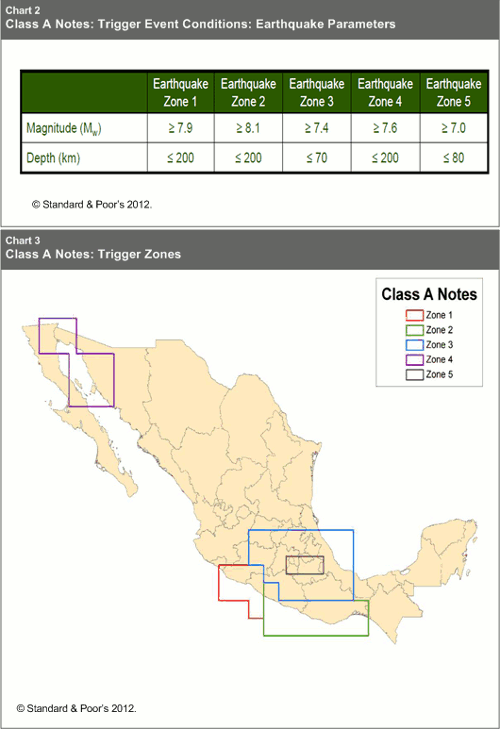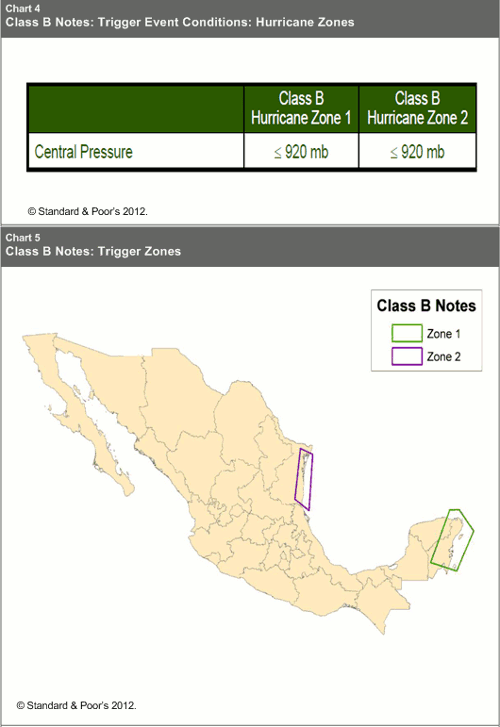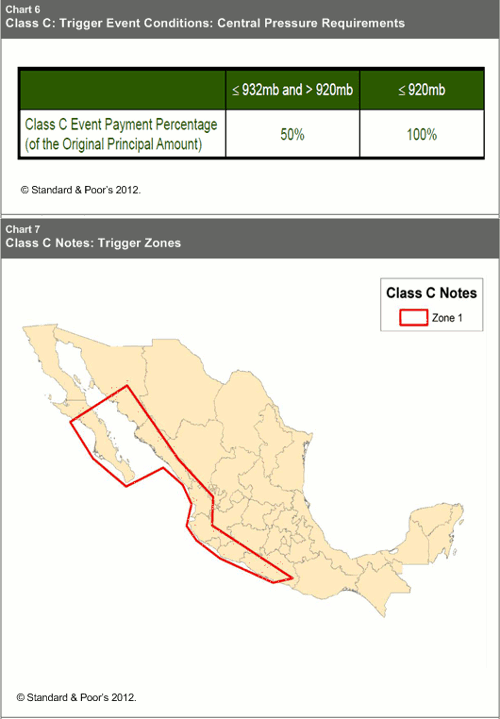Interesting news for the catastrophe bond market today as a new MultiCat Mexico Ltd. cat bond begins marketing. MultiCat Mexico Ltd. Series 2012-1 will replace the cover afforded by the MultiCat Mexico 2009 cat bond which matures at the end of September. MultiCat Mexico 2012 is being marketed as a $300m deal but there is every chance that it could upsize as the diversifying nature of the Mexican hurricane and earthquake risk it seeks to transfer to the capital markets is sure to be attractive to ILS and cat bond investors.
The MultiCat Mexico 2009 cat bond is one of the most discussed transactions of all time as it was devised with the help of the World Bank as a way of helping developing economies to transfer large-scale disaster risk. The cat bond structure was never repeated in other parts of the world so it is encouraging for the MultiCat Program that Mexico is seeking to repeat the deal and returning to the capital markets for some of their natural disaster risk transfer and reinsurance once again. We cannot confirm what involvement, if any, the World Bank has in this deal at this time.
The MultiCat Mexico 2012-1 catastrophe bond will ultimately provide protection to The Fund for Natural Disasters of Mexico (FONDEN), via catastrophe insurance through Mexican insurer AGROASEMEX who are in turn reinsured with Swiss Re who are the sponsor, or ceding reinsurer of this cat bond and themselves will effectively have retrocessional reinsurance with MultiCat Mexico thanks to this deal.
The deal will feature three classes of notes. $140m of Class A notes which will provide protection from earthquakes and $60m of Class B and $100m of Class C notes both of which provide protection against hurricanes. All three classes of notes afford protection on a per-occurrence basis. The cat bond transaction is designed to provide retrocessional cover to Swiss Re, but given the underlying reinsurance the deal ultimately benefits FONDEN. The transaction will provide coverage for an expected term of just over 3 years, with maturity slated to be the 4th December 2015.
For the purpose of this transaction, and perhaps future ones, a Cayman Islands special purpose company has been established and it is expected that it will be licensed as a Class B insurer on the island. MultiCat Mexico 2009 was also Cayman Islands domiciled, but this is a new exempted company set up for this deal and potentially to issue future series of notes if required. Swiss Re, as ceding reinsurer, are responsible for any payments due under the retrocession contract between it and MultiCat Mexico.
As in the MultiCat Mexico 2009 cat bond the deal features three parametric triggers, one for each class of notes.
For the $140m earthquake exposed Class A notes, there are five earthquake zones where the epicentre of a qualifying earthquake must be and both the magnitude and depth of any earthquakes will also be used in the parametric trigger. The coverage area is larger than in the 2009 transaction, which only had three earthquake zones, with two new zones in the north of Mexico. You can see the factors which will denote a trigger event and the five earthquake zones for the Class A notes below (taken from the S&P presale documentation). The parametric trigger for earthquake is much more detailed than in the 2009 transaction, where earthquake depth was the same for each zone, although the magnitude parameters did differ.

MultiCat Mexico Ltd. Series 2012-1 Class A notes earthquake zones and trigger parameters
For the $60m Class B tranche of notes, which are the first hurricane exposed tranche, there are two hurricane zones where the central pressure of a hurricane must be below a pre-defined level for a hurricane to qualify as a covered event. Again this is a different structure to the 2009 Multicat cat bond as that had three hurricane tranches of notes, each of which only had one hurricane zone, the 2012 transaction is a much more detailed structure. You can see the central pressure factors which will denote a trigger event and the two hurricane zones for the Class B notes below (taken from the S&P presale documentation).

MultiCat Mexico Ltd. Series 2012-1 Class B notes hurricane zones and trigger parameters
Finally, the $100m of Class C notes, which are also exposed to hurricanes, features one large hurricane zone running down the Pacific coast of Mexico, but has two parameters for the central pressure of hurricanes. This tranche of notes can payout on less severe hurricanes with a higher minimum central pressure as they have a parameter which will allow for a 50% payout of principal. For more severe qualifying hurricanes a 100% payout of principal would occur. Again, this offers much broader protection for the sponsors than the previous MultiCat Mexico 2009 deal afforded. The MultiCat Mexico 2012 cat bond is a much better structure, offering broader protection to the reinsured and ultimately insured parties, but also making the transaction a slightly higher risk investment, which will likely be reflected in the coupon payments. You can see the central pressure factors which will denote both the 50% and 100% trigger event and the single hurricane zone for the Class C notes below (taken from the S&P presale documentation).

MultiCat Mexico Ltd. Series 2012-1 Class C notes hurricane zone and trigger parameters
As you can see from the three parametric zones and associated triggers, this cat bond offers a very broad coverage to the cedent and it is a great example of how parametric triggers can be used to tailor catastrophe bond coverage to a sponsors needs.
As we said above, this deal is a little more risky than the 2009 MultiCat, but only because the cover has been extended and the triggers tailored to a much greater degree. The Class A notes have a probability of attachment of 4.40% and the Class B notes have a probability of attachment of 2.73%. As the Class A and B tranche would be a total loss if any qualifying event occurs their expected losses and probability of exhaustion figures are the same. The Class C notes are slightly different as they can either payout 50% or 100% of the principal depending on the minimum central pressure of a hurricane which passes through the hurricane zone and so they have a probability of attachment of 5.69%, an expected loss of 4.36% and a probability of exhaustion of 3.02%.
For the class A notes, S&P says that there have been six earthquakes since 1787 that would have reached the attachment index point. For the class B notes there have been four historical hurricanes with a central pressure that would have met the conditions for attachment, and S&P notes that these are all events in recent times since 1977. For the class C notes there have been two hurricanes between 1949 and 2004 with a central pressure that would have reached the attachment index point and both would only have resulted in 50% principal loss to the notes investors.
Standard & Poor’s has assigned its ‘B (sf)’, ‘B+ (sf)’, and ‘B- (sf)’ preliminary ratings to the Series 2012-1 class A, B, and C notes respectively which are being issued by MultiCat Mexico Ltd. in this cat bond transaction.
It will be interesting to see how this new MultiCat Mexico Ltd. Series 2012-1 catastrophe bond is accepted by investors. The use of parametric triggers is not as common as it once was, with many recent deals being indemnity based. Hopefully investors will appreciate the transparency that parametric triggers afford and the diversification that Mexican perils offer to their portfolios will certainly be a draw.
We’ll update you as MultiCat Mexico Ltd. Series 2012-1 comes to market.
You can read more details about this transaction in our Deal Directory.
Read our archive of articles regarding the MultiCat Mexico 2009 deal and the MultiCat Program which do make for interesting reading as there have been a number of catastrophe events which threatened the 2009 deal but did not qualify under the terms of the parametric triggers.
 View all of our Artemis Live video interviews and subscribe to our podcast.
View all of our Artemis Live video interviews and subscribe to our podcast.
All of our Artemis Live insurance-linked securities (ILS), catastrophe bonds and reinsurance video content and video interviews can be accessed online.
Our Artemis Live podcast can be subscribed to using the typical podcast services providers, including Apple, Google, Spotify and more.































